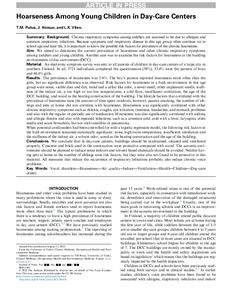Hoarseness Among Young Children in Day-Care Centers
Putus Tuula M; Atosuo Janne; Vilén Liisa K
https://urn.fi/URN:NBN:fi-fe2022112967751
Tiivistelmä
Background
Chronic respiratory symptoms among toddlers are assumed to be due to allergies and common respiratory infections. Because symptoms and respiratory disease in this age group often continue on to school age and later life, it is important to know the possible risk factors for prevention of the chronic hoarseness.
Aim
We aimed to determine the current prevalence of hoarseness and other chronic respiratory symptoms among toddlers and young children. Another aim was to examine the risk factors for hoarseness in the building environments of day-care centers (DCC).
Material
An electronic symptom survey was sent to all parents of children in day-care centers of a large city in southern Finland. In all, 3721 individuals completed the questionnaire (38%), 53.4% were the parents of boys and 46.6% girls.
Results
The prevalence of hoarseness was 5.6%. The boy's parents reported hoarseness more often than the girls, but no significant difference was observed. Risk factors for hoarseness in a built environment in this age group were noise, visible dust and dirt, mold and a cellar like odor, a sewer smell, other unpleasant smells, stuffiness of the indoor air, a too high or too low temperatures, a cold floor, insufficient ventilation, the age of the DCC building, and wood as the bearing construction of the building. The lifestyle factors that correlated with the prevalence of hoarseness were the amount of time spent outdoors; however, passive smoking, the number of siblings and pets at home did not correlate with hoarseness. Hoarseness was significantly correlated with other chronic respiratory symptoms such as rhinitis, coughs, eye irritation, tiredness, headaches, and stomach problems and also with the regular or periodic use of medication. Hoarseness was also significantly correlated with asthma and allergic rhinitis and also with repeated infections, such as a common cold, cold with a fever, laryngitis, otitis media and acute bronchitis, but not with tonsillitis or pneumonia.
When potential confounders had been controlled for with a logistic regression model, the following risk factors in the built environment remained statistically significant: noise, high room temperature, insufficient ventilation and the stuffiness of the indoor air, a solvent odor, wood as the bearing construction and the age of the building.
Conclusions
We conclude that in day-care centers, buildings should be maintained, cleaned and ventilated properly. Concrete and brick used in the construction were protective compared with wood. The acoustic environment should be planned to reduce noise indoors and solvent based chemicals should be avoided. Neither having pets at home or the number of siblings were risk factors, but they were also not found to be protective in this material. All measures that reduce the occurrence of respiratory infections probably also reduce chronic voice problems.
Kokoelmat
- Rinnakkaistallenteet [27094]
